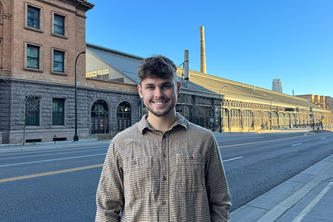
Eliminating plastic waste from the environment is one of the biggest challenges of our age. It's also a big opportunity for scientists and for business.
Only about 9 percent of used plastics are recycled. Those that are recycled by thermo-mechanical processes degrade and become unusable after several cycles. Most plastic waste becomes landfill or litter.
Like rain, most waste plastic flows downward through bodies of water, ending up in the ocean. As it breaks down, it enters the ecosystem. Microplastics, nanoplastics, and PFAS, etc., now appear in the deepest ocean trenches and the highest mountain peaks. They are so ubiquitous that they now appear in our bloodstreams. Microplastics have even been found in breast milk.
When Department of Bioproducts and Biosystems Engineering (BBE) professor Roger Ruan looks at a multicolored mountain of food bags or an ocean island of jugs and personal protective equipment, he sees a gold mine. He knows that the people who figure out how to efficiently turn waste plastic into new products will be the next tech moguls. The unnatural resources they will be able to tap will be vast.
"Ninety percent of all the plastic we’ve produced so far is now in the environment," says Ruan.
The main obstacle to broad, efficient recycling is that waste plastics are made up of many different types of plastic; they are polymers. In order to be used as raw material, polymers must be converted into monomers or naphtha and then into feedstock—the raw materials that manufacturers use to make new plastic products. Complicating matters further, plastics often contain non-reusable fillers to improve functionality and stability or add color.
Ruan has developed a recycling process that echoes the production of raw virgin plastics from petroleum. It uses pyrolysis, a process that heats waste plastics to crack their polymers into volatiles. Next, the volatiles are catalyzed to break them into short-chain chemicals, or monomers—their basic elements. The monomers can be made into feedstocks in the form of wafers.
Ruan's innovation is called catalytic microwave-assisted pyrolysis, or cMAP. A California company called Resynergi has licensed the process and Ruan is its chief technical advisor on the project. It's now in the prototype stage.
Unlike conventional recycling, this process can be repeated an unlimited number of times on the same material, because the monomers are raw material, the equivalent of processed petroleum. "You can always break down into monomers," Ruan explains. "And it can be done with all types of plastic, although with varying levels of complexity."
The next challenge will be to scale up from the current 1.25 tons per day. This is a production problem rather than a supply chain issue, as there are vast amounts of plastic waste in the oceans and other environments.
"We want to send ships to these huge islands of plastics in the ocean to collect the waste plastic and remove them from the environment," Ruan says. That may sound idealistic, but Ruan has a long track record in chemical refining innovation. He has 18 U.S. patents in the areas of food stability, alternative food processes, renewable energy, and the environment. He leads the Center for Biorefining, which facilitates University-industry collaboration for bio-based chemical refining research, development, and education.
Ruan says the theme of his career has been to add value. He and his team are always looking for ways to turn unwanted materials into useful ones that don’t create more waste. "We don't want to treat them as waste,” he says. “We want to treat them as resources."
Learn more about how the U is creating a sustainable campus.




